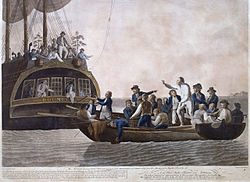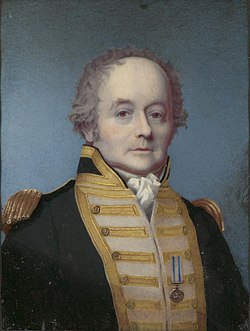HMS Bounty
HMS Bounty, also known as HMAV Bounty, was a sailing ship of the British Navy in which a famous mutiny took place on April 28, 1789, the mutiny of the Bounty.
Vessel history
The ship was initially built as a merchant ship under the name Bethia, although later, after its acquisition by the Royal Navy, it underwent major refurbishments to carry out an expedition to the South Sea carrying a cargo of breadfruit trees from Tahiti, in Polynesia, to the Caribbean, which could be used to feed plantation slaves in Jamaica and other British colonies in the West Indies then suffering from periodic famines. The usefulness of the plant had already been noticed in 1769, by Captain James Cook, who verified that, in addition to being quite common in those islands, it served as food for the Polynesians. When this news spread after the death of the famous navigator and explorer, some West Indian planters asked the President of the Royal Society, the naturalist sir Joseph Banks, the possibility of transporting it to the Caribbean to see if it could be saved. extensive planting. Banks himself was the one who, once this initiative was accepted, which would be sponsored by the royal navy, interceded with those responsible for the Admiralty so that Lieutenant William Bligh, 33 years old, with whom he had shared one of James Cook's exploratory voyages across the Pacific a few years earlier.
Commanding a crew of 44, Bligh set sail on December 23, 1787, from the Thames estuary. The orders that he had were to reach the islands of La Sociedad, present-day French Polynesia, through South America through Cape Horn. However, unusual storms and persistent headwinds prevented him from crossing to the Pacific, so he had to return to the Atlantic to reach Polynesia via the Cape of Good Hope and the Indian Ocean. After ten months of navigation, the Bounty finally reached Tahiti, anchoring in Matavai Bay on October 25, 1788.
Due to the delay suffered, Bligh had to remain on the island for five months waiting for the propitious season to transplant the tree buds, waiting that far from being tedious allowed them to enjoy the natural charms of the paradisiacal island and the attentions of the hospitable Tahitians.
Once 1,051 seedlings had been taken on board, on April 4, 1789, the Bounty set sail again for the Caribbean. One day, when they were between the islands of Tofoa and Kotoo, Bligh noticed that some coconuts were missing. He accused the crew of having stolen them and seriously insulted the officer attached to the second, named Fletcher Christian, whom he publicly called a "damn dog". The commander ordered grog rations to be reduced and threatened to throw anyone caught in a robbery into the sea. His violent attitude exasperated the spirits of the sailors and above all provoked Christian's anger at seeing himself treated so offensively and unfairly. Based on the subsequent statements of the witnesses before the court martial, it seems that the riot was not premeditated but was arranged at the last minute, perhaps that same morning. Seized with strong agitation (some witnesses said they had seen him cry that night on the bow of the ship) Christian seemed determined at first to abandon the ship, but then he changed his mind and decided to take more drastic measures, taking advantage of a fatal accident his watchroom coincided with the service of several crewmen who had been repeatedly punished by the irascible Bligh and who must also have had reason to take revenge on their commander.
After five in the morning of April 28, according to the statements taken by the military judges, the conspirators appeared on the bridge armed with rifles and bayonets and despite being a few, quickly seized the ship without finding practically any no opposition. After threatening to kill the commander if he resisted, they loaded him into the boat along with 18 other crew members, a sextant, some barrels of water, and some food. Another 13 sailors who refused to join the mutineers had to remain on the ship due to lack of space on the boat.
At 8 in the morning the boat left the Bounty and Bligh and his companions were abandoned to their fate in the vicinity of the island of Tofua, very far from any European enclave or port. The voyage that followed in that fragile 7.5 meter long boat to Malaysia constitutes a true nautical feat, considering that it was a small boat without a cover and therefore lacking protection against the sun, rain and waves. They lacked proper nautical charts and was overburdened with dwindling food and water resources. Despite this, and using his undoubted technical knowledge, Bligh managed to reach the Dutch port on the island of Timor in the Moluccas, after 41 days of voyage. He had traveled some 5,800 km in the open sea and despite this, only one man had to be lamented, killed in a confrontation with the natives during one of the landfalls to stock up on water and food, although several more died in the weeks following their arrival in Timor due to the hardships suffered in their long odyssey. When Bligh arrived in England, he had to submit to a court-martial for the loss of the ship, but the trial resulted in his free acquittal. The Navy dispatched the frigate HMS Pandora under the command of Captain Edward Edwards with the mission of bringing the rest of the crew to England and clarifying their participation in the events.
On board the Bounty there were 25 men left in total, of those actually involved in the mutiny Christian and eight or nine sailors. After throwing the potted plants overboard, they decided to return to Tahiti. There they disembarked 16 men, waiting for an English ship to take them back to their homeland. The mutineers then set sail, taking with them 17 natives, six men and eleven women, one of them with a baby. After several days of navigation, they sighted the island of Pitcairn, located about 1,300 miles southeast of the Tahiti archipelago, which at that time was mapped in the wrong position, which made it an ideal refuge as it was not locatable by ships of the Royal Navy who would surely be sent in search of him. On January 23, 1790, once the belongings on board had been transferred and part of the hull had been dismantled, they burned the rest to erase all traces of the ship. With the wood and tools they built several cabins that were also conveniently camouflaged so as not to be seen from the sea.
It was not until 1808 when the island was visited again by another ship, in this case American. By then Christian and most of the mutineers had died in various clashes between the Europeans themselves or at the hands of the Tahitians caused by the possession of women and the distribution of land on the island. The last mutineer, John Adams, died in 1829. His descendants continue to reside on Pitcairn today, although in 1856 a part of the population was displaced to Norkfolk Island, between New Zealand and Australia.
Of the 10 surviving prisoners of the sinking of HMS Pandora, four had favorable testimony from Bligh and were acquitted; two others were convicted but later received a royal pardon; one more was convicted, but acquitted on a legal technicality. The remaining three were convicted and executed by hanging.
On the incidents of that memorable trip, Bligh published in 1790 a narrative, logically in an exculpatory sense, titled in the style of the time Relation of the events that occurred on the ship the Bounty, belonging to the King of England and Commanded by Lieutenant W. Bligh, with the subsequent voyage of this officer and a part of his crew in the longboat from the Amistad Islands in the South Sea to Timor, the Dutch settlement of the Moluccas Islands.
The Bounty in popular culture
Literary and film versions of the mutiny on the Bounty have been made; between them:
Literature
- Julio Verne published in 1879 a short story: The Bounty mutineers (Les révoltés de la Bounty). The original text was written by Gabriel Marcel (1843-1909), a geographer of the National Library of Paris. Julio Verne's work was correct. According to the information available in a document dated 27 July 1879, Verne purchased all rights for about 300 francs.
- Another literary version is Trilogy of the BountyC. Nordhoff and J. N. Hall, 1932-1934.
- Caroline Alexander recreated the episode in The Bounty: the true story of the Bounty riot, using a wide documentation (Spanish edition: Ed. Planet, 20059.
- John Boyne published Fashion at the Bounty in 2008.
Cinema
- The first version of the event is Australian mute film The Mutiny of the Bountyled by Raymond Longford in 1916.
- The second version, also Australian, is In the Wake of the Bounty, film directed by Charles Chauvel in 1933 and starring Errol Flynn in his first appearance before the cameras.
- The third version, the first American and most international, is Mutiny on the Bounty (1935), based on the novels of Nordhoff and Hall. Directed by Frank Lloyd and starred at Charles Laughton and Clark Gable. It premiered in Spain Rebellion aboard.
- The fourth version, best known, is Mutiny on the Bounty (1962), led by Lewis Milestone and starring Marlon Brando, Trevor Howard and Richard Harris. His argument is equally based on Nordhoff and Hall novels.
- The fifth and most recent is The Bounty (1984), led by Roger Donaldson and starring Anthony Hopkins, Mel Gibson, Laurence Olivier, Liam Neeson and Daniel Day-Lewis.
- In the movie Star Trek IV: Mission: Save EarthThere is a reference to this sailboat, when the crew renames the Klingon ship with which they return from Vulcan to Earth with the name "HMS Bounty".
Television
- The History of Bounty is told in the chapter The Simpsons "The Wettest Stories Ever Told."
Contenido relacionado
Snoring snoring
Miguel Cabrera (painter)
Rome, open city

